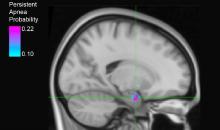Seizure activity in the amygdala may help explain sudden unexpected death in epilepsy

WHAT:
A research team supported by the National Institutes of Health has identified a part of the brain that may be associated with breathing failure following a seizure in people with severe epilepsy that cannot be controlled with medication. The condition, known as sudden unexpected death in epilepsy (SUDEP), is the leading cause of death in this patient population. The new findings, by researchers at the University of Iowa, Iowa City, and published in JCI Insight, may play a critical role in understanding SUDEP, for which causes are not well-explained.
Most cases of SUDEP are thought to be due to loss of breathing that occurs after a seizure ends, known as postictal apnea. The study found that individuals who experience postictal apnea lose a sense of “air hunger” – the primal urge to breathe – or alarm, suggesting that the brain may be unable to detect and respond to rising carbon dioxide (CO2) levels in the blood when the apnea occurs.
To examine this, researchers enrolled 12 adults and eight children with epilepsy that could not be controlled with medications, and who were undergoing intracranial electroencephalography (iEEG) in an attempt to control their seizures. iEEG involves placing electrodes inside the skull to record electrical activity from the brain and to locate where seizures are starting. Using direct electrical stimulation, the team induced seizures in the participants under medical supervision to examine forebrain control of breathing and apnea. They found that seizures that originate in the amygdala, a brain region primarily involved in processing emotion and fear, can cause postictal apnea and identified the amygdala subregion involved in prolonged breathing loss. Only five of the 20 participants developed postictal apnea, suggesting that some individuals with uncontrolled seizures may be more prone to the condition.
The scientists then used a technique combining electrical stimulation with functional MRI to identify novel connections between the amygdala site and the brainstem region critical for sensing changes in blood CO2 levels and controlling breathing. Taken together, the findings suggest that seizure activity in a subregion of the amygdala can suppress breathing and air hunger for prolonged periods of time following seizure. This is likely controlled via connections with the brainstem and other brain sites involved in sensing signals from the body. Additional studies are needed to confirm the role of the amygdala in breathing suppression and its involvement in SUDEP.
The findings further increase understanding of SUDEP and may help uncover preventative treatments and identify those most at risk. The study was funded in part by the National Institute of Neurological Disorders and Stroke (NINDS), part of NIH.
This study was supported by NINDS (R01 NS113764, K08 NS112573 01, 5K12NS080223), the National Institute on Drug Abuse (R01DA052953), and the National Institute of General Medical Sciences (T32 GM067795). Additional support came from the Congress of Neurological Surgeons, Oxford University Hospitals NHS Trust, University of Oxford, Roy J. Carver Charitable Trust, and the U.S. Department of Veterans Affairs.
WHO:
Vicky Whittemore, Ph.D., program director, NINDS Division of Neuroscience
To arrange an interview, please contact NINDSPressTeam@ninds.nih.gov.
ARTICLE:
Harmata GIS, Rhone AE, et al. “Failure to breathe persists without air hunger or alarm following amygdala seizures.” Oct 3, 2023. JCI Insight. DOI: https://doi.org/10.1172/jci.insight.172423
###
NINDS is the nation’s leading funder of research on the brain and nervous system. The mission of NINDS is to seek fundamental knowledge about the brain and nervous system and to use that knowledge to reduce the burden of neurological disease.
About the National Institutes of Health (NIH): NIH, the nation's medical research agency, includes 27 Institutes and Centers and is a component of the U.S. Department of Health and Human Services. NIH is the primary federal agency conducting and supporting basic, clinical, and translational medical research, and is investigating the causes, treatments, and cures for both common and rare diseases. For more information about NIH and its programs, visit https://www.nih.gov.
